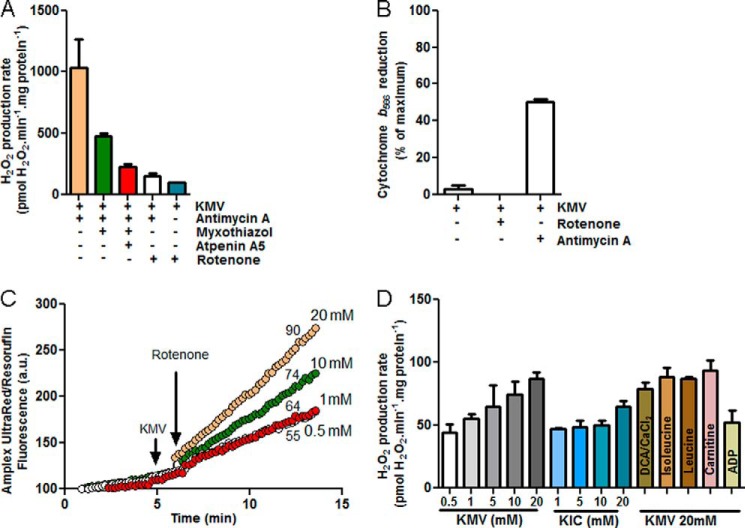FIGURE 6.
The branched-chain 2-oxoacid dehydrogenase complex produces superoxide/H2O2. A, mean rates of H2O2 production with 20 mm KMV in non-phosphorylating medium in the presence of 2 μm antimycin A (beige bar), 2 μm antimycin A plus 2 μm myxothiazol (green bar), 2 μm antimycin A, 2 μm myxothiazol and 2 μm atpenin A5 (red bar), 2 μm antimycin A plus 4 μm rotenone (white bar), and 4 μm rotenone (blue bar). Data are the means ± S.E. (n = 3). B, cytochrome b566 reduction state in non-phosphorylating medium in the presence of 20 mm 3-methyl-2-oxopentanoate plus 4 μm rotenone or plus 2 μm antimycin A. C, typical Amplex UltraRed traces indicate that mitochondria suspended in non-phosphorylating medium with different concentrations of 3-methyl-2-oxopentanoate as substrate generated H2O2. Rates were greatly enhanced by the addition of 4 μm rotenone. a.u., arbitrary units. Arrows indicate additions; numbers indicate mean rates in pmol of H2O2·min−1·mg of protein−1 (n ≥ 3). D, mean rates of H2O2 production in non-phosphorylating medium in the presence of the branched-chain 2-oxoacids KMV or KIC at different concentrations and with 20 mm 3-methyl-2-oxopentanoate in the presence of 4 μm rotenone and 450 nm free Ca2+ plus 1 mm dichloroacetate (DCA), 1 mm isoleucine, 1 mm leucine, 1 mm carnitine, or 2.5 mm ADP. Data are the means ± S.E. (n = 3).

